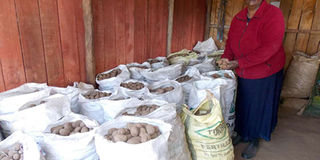How to keep rodents away from your farm without using poison

A farmer with her harvested potatoes in a storeroom in her farm. Although grain is their favourite food, rodents can eat anything organic from animal or plants in the farm. FILE PHOTO | NMG
What you need to know:
- Rats and mice are confused as the same animal more often than not and although they come from the rodent order, they are morphologically different with the mouse being smaller in size.
- Despite the mess creation ability, the rodents are very clean animals and spend a substantial amount of time grooming and cleaning not only themselves but their colleagues.
- Maintaining closed screens is as important as installing them. The manholes and drains should have covers that are always firmly attached.
- Indoors, edible items such as animal feeds should be kept in sealed metal containers and if in sacks, they should be placed on racks above the ground level and a few feet away from walls.
Research has shown that rodents (rats, mice and gerbils) steal almost a quarter of all stored and standing grain. Although grain is their favourite food, they can eat anything organic from animal or plant.
As pest control transforms from purely chemical to Integrated pest management (IPM), which combines chemical technique with other environmental friendly methods, it is important to learn these alternatives.
For successful IPM in rat control, one has to understand the rat and its behaviour and also the different control methods that include and not limited to physical, biological and chemical control activities.
Rats and mice
Rats and mice are confused as the same animal more often than not and although they come from the rodent order, they are morphologically different with the mouse being smaller in size.
The adult mouse can be distinguished from a young rat by the head and feet. Those of mouse are distinctly smaller in proportion to its body size.
However, both have a high birth rate and can produce between 5 and 20 offsprings in as many as 15 times in year. They also have an agile body and they can climb and even run on vertical surfaces.
They have one pair of incisor teeth on each jaw which they use to gnaw at objects. The rodents can shred paper, poke holes in piles of clothes and transform valuables into garbage.
Despite the mess creation ability, the rodents are very clean animals and spend a substantial amount of time grooming and cleaning not only themselves but their colleagues.
The presence of the rodents can be recognised through faecal materials, tracks, burrows, gnawing activity, and rat sounds. The later have sometimes been described as laughter especially when there is plenty of food.
Control methods
a) Physical
Building design and construction
Rat-proof construction should be implemented not only for the farm house but also all other farm structures where edible materials are likely to be stored.
Rat-proofing include screens for doors, windows, ventilations and drains. The screens could be made of stainless heavy duty mesh.
Foundations of such buildings should extend to a depth of at least 3ft below the ground level with a concrete pavement of 3-4 feet wide (rats prefer ducking in instead of running on exposed surfaces).
Maintaining closed screens is as important as installing them. The manholes and drains should have covers that are always firmly attached.
An alternative to a strong foundation is a raised floor for stores and animal houses such as sheep, chicken and calves that are likely to have full feed troughs most of the time.
The poles that raise the floor should have an inverted metal cup structure at their apex, which forms the base of the house. These cups form blind corners that the rats can’t go around.
Sanitation
Rats and mice are attracted by food materials which make indoor and outdoor cleanliness an important control tool.
Outdoors, garbage should be kept in closed containers; the concrete pavement around the house should be kept clean; nearby hiding places like bushes, immobile vehicles and piles of wood, sacks and other trash should be removed.
Indoors, edible items such as animal feeds should be kept in sealed metal containers and if in sacks, they should be placed on racks above the ground level and a few feet away from walls.
Traps
Snap traps, glue boards and other methods of catching the rodents are available. However, some have ethical concerns that include trapping of the animals and keeping them in the traps until they die of starvation like in the case of rarely inspected glue boards.
b) Biological methods
Like the rat, the cat has an agile body and can climb and run on surfaces making it lethal for the rats. Unlike the rat which has poor vision, the cat can see even in the dark and it also has an acute sense of smell and sharp ears.
Further, cat’s love for meat makes hunting rats a necessity especially in places where they are fed with plant material like ugali.
c) Chemical methods
Anti-coagulants and non-anticoagulants can be used as a short time control measure as one prepares to adopt non-chemical methods.
d) Anticoagulants
Anti-coagulants preparations such as warfarin are slow acting. They kill the animal by preventing blood coagulation thus causing internal haemorrhage.
Non-target animals like dogs and cats which can accidentally feed on dead rats are not at risk of dying unless a big number is consumed at once or in combination with the bait. Vitamin K is the antidote for anticoagulants.
e) Non-anti-coagulants
These include chemicals like Zinc phosphide that kill within a few hours and this might make some rats not to eat them as they comprehend that their colleagues are dying.
Dr Mwirigi is a livestock expert and can be reached at [email protected]



